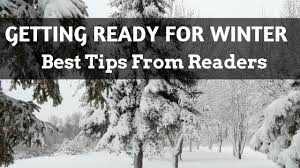Although winter comes as no surprise, many of us are not ready for its arrival. If you are prepared for the hazards of winter, you will be more likely to stay safe and healthy when temperatures start to fall.
Many people prefer to remain indoors in the winter, but staying inside is no guarantee of safety. Take these steps to keep your home safe and warm during the winter months.
- Winterize your home.
- Install weather stripping, insulation, and storm windows.
- Insulate water lines that run along exterior walls.
- Clean out gutters and repair roof leaks.
- Check your heating systems.
- Have your heating system serviced professionally to make sure that it is clean, working properly and ventilated to the outside.
- Inspect and clean fireplaces and chimneys.
- Install a smoke detector. Test batteries monthly.
- Have a safe alternate heating source and alternate fuels available.
- Prevent carbon monoxide (CO) emergencies.
- Install a CO detector to alert you of the presence of the deadly, odorless, colorless gas. Check batteries regularly.
- Learn symptoms of CO poisoning: headaches, nausea, and disorientation.
Get your car ready for cold weather use before winter arrives.
- Service the radiator and maintain antifreeze level; check tire tread or, if necessary, replace tires with all-weather or snow tires
- Keep gas tank full to avoid ice in the tank and fuel lines.
- Use a wintertime formula in your windshield washer.
- Prepare a winter emergency kit to keep in your car in case you become stranded. Include
- blankets;
- food and water;
- booster cables, flares, tire pump, and a bag of sand or cat litter (for traction);
- compass and maps;
- flashlight, battery-powered radio, and extra batteries;
- first-aid kit; and
- plastic bags (for sanitation).
- Be prepared for weather-related emergencies, including power outages.
- Stock food that needs no cooking or refrigeration and water stored in clean containers.
- Keep an up-to-date emergency kit, including:
- Battery-operated devices, such as a flashlight, a National Oceanic and Atmospheric Administration (NOAA) Weather Radio, and lamps;
- extra batteries;
- first-aid kit and extra medicine;
- baby items; and
- cat litter or sand for icy walkways.
- Many people spend time outdoors in the winter working, traveling, or enjoying winter sports. Outdoor activities can expose you to several safety hazards, but you can take these steps to prepare for them:
- Wear appropriate outdoor clothing: layers of light, warm clothing; mittens; hats; scarves; and waterproof boots.
- Sprinkle cat litter or sand on icy patches.
- Learn safety precautions to follow when outdoors.
- Be aware of the wind chill factor.
- Work slowly when doing outside chores.
- Take a buddy and an emergency kit when you are participating in outdoor recreation.
- Carry a cell phone.
- Protect your family from carbon monoxide.
- Keep grills, camp stoves, and generators out of the house, basement and garage.
- Locate generators at least 20 feet from the house.
- Leave your home immediately if the CO detector sounds, and call 911.
When planning travel, be aware of current and forecast weather conditions.
Avoid traveling when the weather service has issued advisories.
- If you must travel, inform a friend or relative of your proposed route and expected time of arrival.
- Follow these safety rules if you become stranded in your car.
- Stay with your car unless safety is no more than 100 yards away, but continue to move arms and legs.
- Stay visible by putting bright cloth on the antenna, turning on the inside overhead light (when engine is running), and raising the hood when snow stops falling.
- Run the engine and heater only 10 minutes every hour.
- Keep a downwind window open.
- Make sure the tailpipe is not blocked.
Above all, be prepared to check on family and neighbors who are especially at risk from cold weather hazards: young children, older adults, and the chronically ill. If you have pets, bring them inside. If you cannot bring them inside, provide adequate, warm shelter and unfrozen water to drink.
No one can stop the onset of winter. However, if you follow these suggestions, you will be ready for it when it comes.
Also regarding health lets look at what most people do in the WINTER as opposed to the SUMMER (hot weather):
Winter weight gain isn’t just an urban myth. Research has shown that most of us could gain around a pound (half a kilo) during the winter months. That may not sound like much, but over the course of a decade, it can add up.
“There’s good evidence that people put on weight over the winter,” says dietitian Sian Porter. “The more overweight you are, the more you tend to put on. And the most worrying aspect of this seasonal weight gain is that the pounds tend to stay on. People don’t seem to lose the extra weight.”
The three main reasons that people put on weight in the winter are lack of physical activity, comfort eating and over-indulging at Christmas.
Cold weather and shorter days make it harder to exercise outdoors, so it’s easy not to do any exercise over winter. If you’re not outside as much, there’s more time and temptation to reach into the kitchen cupboard for high-calorie sweet snacks, such as biscuits and cakes.
Then of course there are the festivities that surround Christmas. “What used to be a couple of days of parties and over-eating now seems, for some, to be six weeks of over-doing it,” says Porter.

